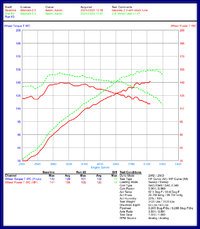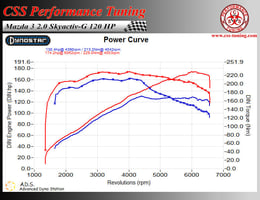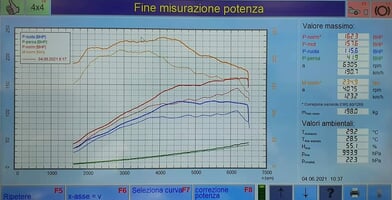Navigation
Install the app
How to install the app on iOS
Follow along with the video below to see how to install our site as a web app on your home screen.
Poznámka: This feature may not be available in some browsers.
Více možností
-
Prosíme nepište moderátorům a správcům soukromé zprávy s technickými dotazy. Největší šance, jak se Vám dostane odpovědi, je položit dotaz do příslušného fóra. Pokud nenajdete správnou kategorii nebo název, založte nové vlákno. V případě potřeby to přejmenujeme nebo přesuneme.
Děkujeme za pochopení, tým správců MazdaKlanu
Používáte zastaralý prohlížeč. Tyto nebo jiné webové stránky se nemusí zobrazovat správně.
Měli byste upgradovat nebo použít alternativní prohlížeč.
Měli byste upgradovat nebo použít alternativní prohlížeč.
BM Skyactiv-G remap
- Vlákno založil Elvino
- Datum založení
- 6 240
That's fine, one just see different engine load limiters that BM/BN have.
Odesláno z mého Mi 10 pomocí Tapatalk
On 100octane probably, as they modify spark advance in massive scale. Plus 4 degree on base tables, plus 3 degree on additive tables. And closed loop tables enleaned on top end. Without high octane impossible as one get huge knock retard.chart of ATM + 10hp and + 20nm on 165G?
Odesláno z mého Mi 10 pomocí Tapatalk
Poslední úprava:
@ReVolte Termodynamické zákony platí pro všechny. Takhle - nižší spotřeba je možná jen s ochuzenou směsí (u dieselu větší vstřikovací tlak a tím pádem rozprášení nafty), ale to se zase není možné příliš zvyšovat předstih pro větší výkon, protože narůstá teplota a snižuje se hranice samozápalů. Takže, že by někdo jezdil za méně, s větším výkonem a bez toho, aniž by tankoval vysokooktanový benzín, nebo E85, je čirá utopie. Skyactiv-G motory upravuju tak, že zachovávám Atkinsonův cyklus, který je umístěn meze 1000 a 3250 ot/min a mezi 20% až 50% zátěž. Tam se nic nemění a je stále možná úsporná jízda. Ale dejme tomu od 80% zátěže a mezi 1500 až 7000 ot, tam je potřeba buďto obohatit směs pro přidání předstihu, nebo ochudit, ale předstih nemůže být o zase moc přidaný a musí se jezdit na N100. Je na výběru každého gurmána, co od toho očekává.
Jestli očekává, že bude jezdit na N95 s "McDonald" předstihem zvýšeným 5 stupňů paušálně, co je obvyklé u masových úprav většiny tuningových firem, tak to fakt nefunguje.
Can you kindly explain a little simpler?
I understood that it can be done in two ways:
- on the VVT for intake and exhaust cams, this gives more thrust at low and medium rpm;
- ignition advance especially with 100 RON + petrol to improve power at high rpm.
Questions:
- is it possible to act in both ways?
- if the advance is tuned for 100RON petrol what happens if I use 95RON petrol?
Were there any problems remaining below a certain rpm threshold? For example 3000 rpm.
- 6 240
Sure, maxing VVT and smoothing EGR area spikes gives is you more thrust in exchange for slightly worse NOx emissions. The method is not revolutionary, it is mostly used on stock ND, whether with 96kW P5 engine or 135 kW PE engine. It only depends on the dimensions of the valves or the length of the exhaust pipes.
Regarding the operation of the car tuned to the 98RON - the fuel mixture (leaner than for 95) and the spark advance (higher than for 95) - with 95RON - you can always run ForScan Lite and watch the knocking retard on your mobile. You'll come across it from, say, 4000 RPM and 75% load (simply, for a gasoline naturally aspirated engine, it's % of maximum MAF air flow). Continuous operation is not something that would be suitable, however this direct injection engine is somehow adapted to last some knocking. These engines have several advance maps, usually some basic and then additional in the logic high load - low detonation (= 98RON, the map that is most often modified), low load - low detonation, high load - high detonation, low load - high detonation (low octane maps). Within the range of these maps, the PCM regulates the spark advance according to the fuel quality based on the knock sensor (piezoelectric microphone) - there is no other way to adapt to fuel quality.
Regarding the operation of the car tuned to the 98RON - the fuel mixture (leaner than for 95) and the spark advance (higher than for 95) - with 95RON - you can always run ForScan Lite and watch the knocking retard on your mobile. You'll come across it from, say, 4000 RPM and 75% load (simply, for a gasoline naturally aspirated engine, it's % of maximum MAF air flow). Continuous operation is not something that would be suitable, however this direct injection engine is somehow adapted to last some knocking. These engines have several advance maps, usually some basic and then additional in the logic high load - low detonation (= 98RON, the map that is most often modified), low load - low detonation, high load - high detonation, low load - high detonation (low octane maps). Within the range of these maps, the PCM regulates the spark advance according to the fuel quality based on the knock sensor (piezoelectric microphone) - there is no other way to adapt to fuel quality.
Sure, maxing VVT and smoothing EGR area spikes gives is you more thrust in exchange for slightly worse NOx emissions. The method is not revolutionary, it is mostly used on stock ND, whether with 96kW P5 engine or 135 kW PE engine. It only depends on the dimensions of the valves or the length of the exhaust pipes.
Does Versatune apply these modifications of the VVT for miata 2.0 nd? Or just change the ignition advance?
- 6 240
Yes, not so much as it could be, but yes.Does Versatune apply these modifications of the VVT for miata 2.0 nd?
Versatune presented on its Facebook page the dyno chart of a Mazda3 2.0 skyactiv-G after mapping the ECU with 93 octane petrol (98 RON).
The graph has me very puzzled because the power is too little to be at the shaft and too much to be at the wheels (estimating a loss of 20% for the transmission).
From the torque curve (low compared to other graphs of the same engine) I don't think any changes have been made in the VVT timing, but only changes in the ignition advance.
In short, it seems to me disappointing for the results but also for the inaccurate presentation, like the graph of the mx-5 ND1.

The graph has me very puzzled because the power is too little to be at the shaft and too much to be at the wheels (estimating a loss of 20% for the transmission).
From the torque curve (low compared to other graphs of the same engine) I don't think any changes have been made in the VVT timing, but only changes in the ignition advance.
In short, it seems to me disappointing for the results but also for the inaccurate presentation, like the graph of the mx-5 ND1.

- 6 240
This oscillation on top end usually indicated not learned knocking correction = too much spark timing advance.Versatune stated that it did not make any changes to the VVT and that the car used was stock.
I have many doubts that it is stock, (air filter and exhaust).
Then they put a bigger advance trusting that the ecu in the case of detonation will adapt by reducing the ignition advance.Note that "universal" tuners do not take KNOCKR into account at all.
Podobná vlákna
- Odpovědi
- 9
- Zobrazení
- 2K
- Odpovědi
- 0
- Zobrazení
- 617
- Článek
- Odpovědi
- 0
- Zobrazení
- 627
- Odpovědi
- 36
- Zobrazení
- 8K
- Připnuté
- Odpovědi
- 1K
- Zobrazení
- 206K

